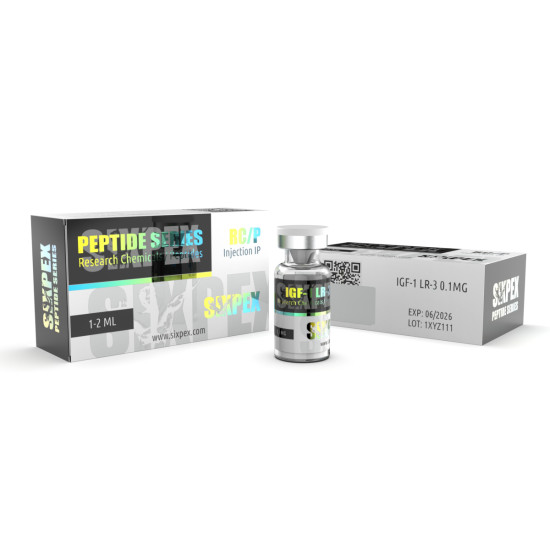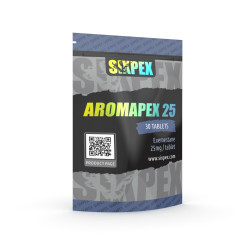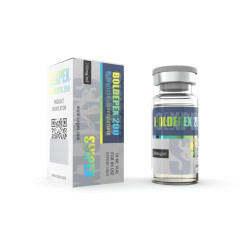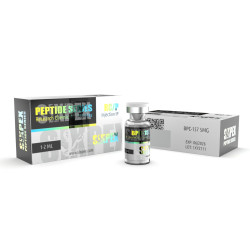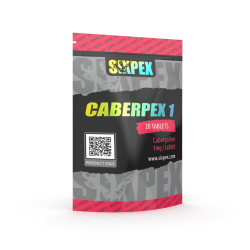The Comprehensive Guide to IGF-1 LR-3 Usage in Bodybuilding
1. Introduction to IGF-1 LR-3
IGF-1 LR-3 is the most widely used form of insulin-like growth factor by bodybuilders. A recombinant analogue of human growth hormone produced using the recombinant RNA method, IGF-1 LR-3 is a variant of the IGF-1 hormone produced naturally in the body. IGF-1 LR-3 produces many of the same effects as HGH, like muscle growth, fat loss, and a number of other desirable performance-enhancing effects. Although IGF-1 LR-3 hasn't yet reached the level of notoriety of human growth hormone, it's a popular acute performance enhancer and bodybuilding supplement and is often used by recovering athletes due to its ability to trigger muscle growth. Researchers are currently exploring the substance's potential for producing other notable health effects that go beyond the scope of exercise.
IGF-1, formally known as insulin-like growth factor, is an endocrine hormone produced in the liver in response to growth hormone. Its natural function is to promote growth and metabolism throughout the body by binding to one of the two cell surface receptors, IGF-1R and the insulin receptor. When the IGF-1 hormone binds to the appropriate receptor, signaling processes are turned on that promote muscle hypertrophy, inhibit muscle atrophy, and support the efficient use of energy. In the context of performance, increased levels of IGF-1 LR-3 may reduce recovery times between workouts and assist bodybuilders in gaining muscle mass. In this way, IGF-1 can be used to increase both lean mass and the amount of weight that you're able to lift. The level of lean mass that you can carry is directly related to how much weight you're able to lift. In deepening our understanding of IGF-1 LR-3, we explore the mechanisms activated by IGF-1, how to use it, and for what purposes.
1.1. What is IGF-1 LR-3?
What is IGF-1 LR-3? 1.1.
IGF-1 LR-3 stands for insulin-like growth factor 1 long arginine 3. It is a modified analog of IGF-1. As an analog of IGF-1, it shares a 100% identical amino acid structure with its parent hormone, apart from one crucial difference: IGF-1 LR-3 has an additional 13 amino acid ester chain attached to its structure. This virtually doubles its receptor-binding affinity, decreasing its binding to IGF-1 binding proteins in the blood, thus increasing its half-life to about 20–30 hours. This half-life is significantly longer than native IGF-1’s half-life of only 10–20 minutes.
When applied to its binding locations, such as skeletal muscle and connective tissue, IGF-1 LR-3 can alter the expression of a variety of genes, influencing intracellular metabolism. IGF-1 LR-3 initiates a cascade of events, which results in the activation of something called ribosomal mRNA translation and a host of anabolic entry points that elicit muscle hypertrophy and hyperplasia. The most prominent anabolic entry point of IGF-1 LR-3 is at the satellite gene, which is responsible for allowing the muscular tissue to repair and replicate itself through a process known as capillary mitosis. This cascade makes IGF-1 LR-3 a powerful growth-promoting agent. Since its activity encourages muscle cell replication and hypertrophy, a number of bodybuilders and athletes use it.
IGF-1 LR-3 has been a part of medical research from as early as the 1970s in a search to create synthetic IGF-1. After much experimentation, a research team was able to create a synthetic IGF-1 analog, a construction known as des(1–3) IGF-1, which stood for the amino acid residues that were removed from the natural protein. A little more than a decade later, most notably in the mid-1990s, it was researched as a potential treatment for individuals with growth hormone receptor deficiencies. It has since been used to treat specific eating disorders, burn victims, especially those with cystic fibrosis. In the sporting world, it was only after display on the bodybuilding scene that the performance-enhancing world began to show interest.
1.2. Importance of IGF-1 LR-3 in Bodybuilding
If you are into bodybuilding, one of the main priorities for you is the levels of IGF-1, particularly the more powerful version, IGF-1 LR-3. It's these levels that are going to decide whether you'll ever get a lot of muscle mass or be able to move a whole lot more weights, as well as how speedy the recovery from training will be. Of course, loads of it are related to the workouts and nutrition, but believe us, IGF-1 LR-3 possession and circulation are pure gold to every serious athlete. Normal growth of the cells in your body means an increase in their number. Sounds good to us, and in theory, there would additionally be a rise in muscle mass and, of course, overall strength. Then comes the even more important property - IGF-1 LR-3 is up to three times more powerful than even healthy IGF-1 - some people proclaim it can actually produce three to four times greater rates of muscle growth. Now you know why weightlifters are so enthusiastic about exogenous IGF-1 LR-3. Today, there are countless anabolic steroids used in bodybuilding. Each one has unique properties, so if you like something for quick mass effect with some water and fats, go use testosterone and dianabol - it's like a must-have. If you value solid lean muscle mass, Trenbolone makes the top choice. Yet everyone from their granny to the novice or world-renowned bodybuilder has used or experienced testosterone, so what's the big deal? The big deal is when you can surprise this whole crowd with something totally new that the very pros have stayed unacquainted with. IGF-1 LR-3 was developed mainly for bodybuilders. There are more of them, and those who treat sports really seriously do their best to leave the rest of the people behind. That is why they seek everything at once. Recent years have proved that IGF-1 LR-3 can guarantee super effective training for those who neglected the process of somatotropin creation. If you are into sports, you know that if you fail to train at 100%, no achievements can take place.
2. Mechanism of Action
IGF-1 LR-3 mRNA is found in all human tissues in the body, with high expression occurring in the liver, muscle, and peripheral tissues. Released into the bloodstream following the production of HGH, IGF-1 LR-3 is the primary mediator of HGH’s effects. IGF-1 LR-3 possesses the significant effects commonly associated with HGH, including its role in promoting lean muscle growth, increasing bone mineral density, and promoting fat loss. In this regard, IGF-1 LR-3 supplements many anabolic bodybuilding steroid cycles. It interacts with the tissues, boosting telomere and stem cell activation to speed up the healing of muscle and connective tissue, preserve heart and kidney size under excess protein metabolism, boost tissue metabolism, and perhaps aid the heart in its role as a muscle, decrease cholesterol, improve insulin synthesis, and reduce gut fat. IGF-1 LR-3 is mostly anabolic in the muscle tissue as well as connected. IGF-1 LR-3, in collaboration with HGH, helps you grow older by helping you grow fresh muscle cells and repair them as well as fixing tissues in relation to repairing them.
IGF-1 LR-3, just like HGH, acts directly on the target cell tissue to simulate processes involved in tissue growth. This process involves binding to the muscle cell surface receptor, which in turn activates a signaling cascade that stops protein breakdown. This experience allows you to remain anabolic and avoid being catabolic. IGF-1 LR-3 can boost muscle hypertrophy so much that it can compensate for muscle loss due to profound inactivity and disuse, like that which takes place after a significant injury. Furthermore, tests have indicated that it is significantly more anabolic, particularly in muscle tissue, than the parent edition.
2.1. How Does IGF-1 LR-3 Work in the Body?
The expression of IGF-1 is heavily reliant on stimulation by other hormones and growth factors, which often increase in response to various signals like exercise and diet, the most well-known being growth hormone, the action of which acts as a catalyst in IGF-1 production. Once released in large amounts by the liver and peripheral tissues, the circulating IGF-1 is bound to one of the six IGF-1 binding proteins. Once circulating in the blood, approximately 98 percent of IGF-1 binds to an IGF-binding protein such as IGFBP-2, IGFBP-3, IGFBP-4, IGFBP-5, or IGFBP-6, formed in the liver, which regulates the distribution, bioavailability, and escalation of the action of IGF-1. The less active form of IGFBP is then broken down in the liver and subsequently converts into the active form of IGFBP that can no longer be recycled. This process, including conversion steps, determines the ultimate makeup of the IGF-1 that is released into the bloodstream.
Circulating in a dephosphorylated form, only a small percentage of IGF-1 is free in the bloodstream, and thus very biologically active, where it will attract receptors. At this point, it is not optional for IGF-1 to attach specifically to an active binding site called an interesting factor. These meeting stations are usually located on the outside of muscle cells and sometimes insufficiently on connective tissues. IGF-1's restriction to only binding to cells capable of generating new muscle (and related connective tissues and organs) means it forces muscle cell supplementary enlargement but not differentiation; that is, the growth is not accompanied by the formation of new satellite cells. In contrast, stem cells of muscle cell activity or satellite cells are forced to detach by the IGF trifecta of IGF-1 LR3, MGF, and MGFc. Satellite cells are stem cells that are tightly bound to growing muscle. Scientists believe that potent and restricted IGF-1 LR3 triggers about 20 percent of the time has been attributable to its ability to increase satellite cell activity. In turn, satellite cells are the building blocks for synthesizing new lightning-fast muscle. Thus, IGF-1 LR3 both matures the development of growth in perseverance and increases growth by enhancing muscle cell enlargement through spreading. Furthermore, some people prefer to use IGF-1 LR3 to enhance oral steroid relief. This is largely because IGF-1 helps to make steroids more efficient. In other words, it increases the degree to which androgens are captured.
2.2. Key Differences Between IGF-1 and IGF-1 LR-3
IGF-1 Long Three and IGF-1 are distinct in many aspects. IGF-1 has been altered to achieve increased functionality. IGF-1 has a very limited active life except for the IGF-1 receptor when used by some target cells. It is rapidly degraded in the body to a very weak peptide, whereas IGF-1 LR-3 is deprived of it and binds the IGF-1 receptor more effectively, causing a more robust and longer-lasting result. In essence, IGF-1 activates the IGF-1 receptor exclusively. Meanwhile, insulin becomes a primary source of receptor activation with IGF-1 LR-3 while the IGFBP pump of insulin remains strong and interferes with receptor activation.
The anabolic drives it induces between the two can be dramatically different. IGF-1 LR-3 binds the IGF-1 receptor with a 23-fold higher affinity than the original IGF-1 receptor paradigm. In binding the dominant insulin receptor, it also exhibits a high bias against the original variation. The result is the essential responsibility for the anabolic effects in both muscle hypertrophy and regeneration. IGF-1 is hampered by the weak half-life of its serum, as indicated above. Only for a few hours does the deactivation period go into adolescence. Meanwhile, IGF-1 LR-3 is not unaffected by insulin, PGH, or other IGFBP operators in the body, which can contribute to their full potential. Unlike IGF-1, IGF-1 LR-3 is meant to be a usage crossover in the field of bodybuilding. While the flexibility and distinct range of benefits that may be available are certainly evident, it is crucial for bodybuilders to keenly understand the differences between IGF-1 and IGF-1 LR-3 in order to effectively exploit those strengths.
3. Usage Guidelines
Individual differences exist and, consequently, dosing needs to be tailored specifically to each individual's needs, goals, how receptors react to the compound, and the side effects that one experiences. The best practice involves starting with small doses and gradually increasing them so that adequate time may pass to compare the change in dosage with the potential strength gains. In many cases, a range of 50-150 mcg a day is known to be effective when ideal administration guidelines are upheld, and these dosages are indeed regarded as the safest and most efficient. Roughly 50-150 mcg should be taken daily. 150 mcg should be split into two and administered one in the morning and the other in the post-workout period. Those are the most appropriate times of day. Insulin syringes are perfect for the subcutaneous injection as they can easily pierce the skin but still have low-causing depth. IGF-1 is very influential when it comes to large-scale hypertrophy. The in-depth fascia encouraging the growth of muscle tissue, on the other hand, can make the muscles too large and not expansive enough to achieve a thin level of separation. The outcomes will be better if the injections are given bilaterally, which is usually done at least 7 inches from the main muscle area. However, for most, the insulin syringe that the EPO hormone is injected with is the safest approach. If, after consultation with a medical professional, it is believed to be appropriate to begin the application of IGF-1 Lr3, be sure to take alternative doses in the beginning. It's important to note that your system would need to be acclimated to the compound, and this approach can help you avoid potential situations that might only make your body feel uncomfortable. It's always better to be safe than sorry. For these reasons, consulting with a physician before starting is a crucial thing to do if you are inclined to buy IGF-1 Lr3 and start bodybuilding assistance. Some users have found that using it either after or 15 minutes before a workout yields superior results. Apply it at least 40 minutes after the workout if another dosage is going to be taken. A little high or lower than that is acceptable.
3.1. Recommended Dosage and Administration
Most experts recommend dosages ranging from 20 to 100 mcg to get the best results when a person is using IGF-1 LR-3 in a gym. However, people should start at the lowest recommended dose. If one has not experienced any side effects with a dose of 40 mcg, it is safe to increase the dose to 60 mcg. After one has been able to tolerate a high dose of 80 mcg or more, it is safe to say that further dosages are not toxic to the body. Any variation in dosing can lead to serious side effects, or the results may not be achieved. For regular usage, most bodybuilding experts recommend a more conservative dose of 40 to 50 mcg. On the other hand, long-term users, such as those in bodybuilding, can use a moderate dose of anywhere from 75 to 100 mcg. Keep in mind that one must achieve the tolerance dose for any anabolic substance to ensure the best results. How to Use IGF-1 LR3: Administered via subcutaneous injection, IGF-1 LR3 has a 20-day half-life, so most users posit that they can have a break of 4 to 6 weeks between doses. Some users believe that subcutaneous injection is more manageable, less dangerous, and more advantageous compared to intramuscular injection. Users who choose to inject subcutaneously can inject the product across the first deep layer of skin because they have less quick blood circulation, which allows this type of injection to act more effectively on fat tissue for growth. It is especially necessary for new users to assess it in smaller increments than to attempt a complete dosage to evaluate their standard tolerance by their body. In many main chats, users recommend increasing amounts from 20 to 40 mcg for the first few months, particularly for those who have gone through their cycle and have training strength. Users often go high on dosages if they were using more substantial amounts of body fat in their future endeavors because more growth was more necessary. Some users, such as the big guys and bodybuilders, administer a much more elevated dose than those who travel across the training world. Use special tools and a correct way of keeping your drug sterile and safe. Keep the usage of bacteriostatic water at 0.09 percent benzyl alcohol. The safer alternative is saline solution for injections. Use alcohol swabs, too. If safety isn't guaranteed, you can't make the most of using these supplements. Keep in mind that the more ways to reduce the risk of adverse effects, the better. We also follow hygienic hand procedures.
3.2. Cycling Strategies for IGF-1 LR-3
The muscle recovery and hypertrophy properties of IGF-1 make this compound very attractive for bodybuilders, who will run IGF-1 in segmented amounts based upon their workout regimens. Former cyclists usually claim that cycling is important for the safety of the pituitary gland, which loses sensitivity with IGF-1 desensitization. Although IGF-1 is obviously cycled on a day-by-day basis, many athletes will plan to take time off and cycle on a weekly or monthly basis as well, much like they do with HGH supplements. Cycling IGF-1 helps preserve some of the sensitive effects it provides and helps re-establish the body's natural production of insulin growth factor-1. Having just taken IGF-1 for so many weeks or months without taking any time off, your body may potentially become desensitized to the compound. While it gradually loses its efficacy as time progresses, there can still be a degree of lasting hypersensitivity.
Some of you have planned on taking IGF-1 for up to 4-7 weeks depending on the bloated off-cycle schedule. These strategies are particularly noteworthy for athletes who follow stringent off-cycles involving hormonal androgens, thereby allowing them to prevent muscle loss while optimizing the fat-burning potency of their natural IGF-1 being released. If you have plans to cycle IGF-1 like these athletes, you should plan your "on" and "off" phases around your regular cycle time. For instance, if you take HGH for a continuous 12 months, you might take 4-7 weeks off every 3-4 months. Most athletes will schedule their off-cycles to correspond with their gym training schedules, though. For instance, you might notice that you become hypersensitive faster with a mistake than the right one. If you feel like something is off, don't be worried to change it or attempt to fix it. No one knows your body better than you. Therefore, it is considered sensible for bodybuilders and athletes to use IGF-1 in cycles or in combination with anabolic synergistic methods to reach desired fitness and conditioning targets at the competitive and advanced stage as well as overall in bodybuilding and athletics.
4. Effects on Muscle Growth and Performance
IGF-1 LR-3 directly influences improvements in body composition and the functional strength of the muscle. IGF-1 LR-3 is favored among bodybuilding circles for the improvements it can make to muscle hypertrophy. The mechanism of action is primarily anabolic, but there are other positive influences, such as extending the lifter's ability to work at higher than normal intensities, that contribute to muscle growth effects. IGF-1 LR-3 promotes hypertrophy by increasing the amounts of protein produced. Lifting heavy weights leads to structural damage to the muscle, and the release of growth factors assists in repairing that damage.
IGF-1 LR-3 is highly valued by bodybuilders for the improvements it can make to muscle strength and overall performance. Combining IGF-1 LR-3 with lifting weights leads to a far greater extent of muscular hypertrophy than if only exercise is conducted. However, when already undergoing exercise, it's important to allow for recovery, and ensure adequate nutrition is obtained to benefit from the potential results. Admittedly, when downtime is taken to allow for recovery, it also leads to an amino acid transfer back to the liver and not the muscle for the synthesis of protein, and potentially, loss of acquired muscle tissue can come from time spent away from the gym. This results in increased tears in the muscle. The slower the repair, the longer the damaging state on the muscle remains, and it is only very recently that science has discovered that IGF-1 LR-3 has a protective factor enabling that defensive mode to come into place. Evolutionarily speaking, if muscles could not be repaired, there would eventually be none, so it would not be beneficial to have a human body that is prone to losing muscle every time it gets damaged.
4.1. Anabolic Effects of IGF-1 LR-3
IGF-1 LR-3 is one of the most potent anabolic agents on the bodybuilding market, primarily due to its profound anabolic effects. IGF-1 LR-3 directly activates protein synthesis in skeletal muscles, causing an increase in muscle mass over time. Protein synthesis is the process by which cells build proteins using amino acids, and muscle protein synthesis is crucial for muscle hypertrophy. In addition to increasing protein synthesis and muscle hypertrophy, IGF-1 LR-3 also activates satellite cells in muscle in order to promote muscle regeneration and repair. Satellite cells are involved in muscle repair, growth, and regeneration, and IGF-1 LR-3 is one of several growth factors in muscle that can activate satellite cells. Furthermore, IGF-1 LR-3 can also strongly enhance strength levels, which can slightly be related to the anabolic effects on muscle protein synthesis. In addition, IGF-1 LR-3 has been shown to have strong anabolic effects on nitrogen retention and increased nitrogen balance.
Recent studies have confirmed growth factors such as IGF-1, IGF-2, and IGF-binding proteins in human skeletal muscle and other organs that play a vital role in anabolic processes, regulating muscle growth and muscle hypertrophy. For example, in the body, IGF-1 (of which IGF-1 LR-3 is a modified version) is released in response to growth hormone. When GH is released, it stimulates the liver to release IGF-1, which presumably carries the many benefits of GH. Therefore, IGF-1 LR-3 possesses significant anabolic properties due to the mechanism already discussed. Furthermore, it is well documented that GH and IGF-1, when used in combination, exert synergistic anabolic effects. Numerous research studies have reported a high association with aging and muscle loss, which further justifies the need for muscle-building products that contain IGF-1 or an IGF-1 mimetic. Thus, IGF-1 LR-3 clearly possesses the capability to increase muscle mass when used as directed.
4.2. Enhanced Recovery and Repair
The role of IGF-1 LR-3 in enhancing the recovery from and repair of muscle tissues is a very quick benefit of the compound to manifest, often within the first few days of administration. In the bodybuilding world, one of the primary goals is to get back into the gym following a period of intense exercise to prevent overtraining, and IGF-1 LR-3 is very effective in enabling a user to do just that. Variant I can also be used to lessen the severity and duration of common overuse injuries and strains, both of which are significant hurdles in the gym that stagnate increases in strength and size. Regardless of what product is used, the muscle recovery time is reduced significantly when IGF-1 LR-3 is added to a bulking or mass cycle. This effect can be attributed to the compound’s ability to promote the shuttling and use of nutrients by muscle tissues while, at the same time, limiting the beneficial storage of glycogen and amino acids in fat.
And again, this is not something unique to bodybuilding. As a regulatory hormone that is produced naturally by the human body, IGF-1, in addition to promoting the growth of new muscle fibers, acts as a suppressor by minimizing the presentation, strength, and duration of inflammation, in part by facilitating the release of antioxidant scavengers. One of the specific physiological effects of liver-derived IGF-1 is to act as an analgesic by inhibiting the production of chemicals that transmit sensations of pain, by decreasing nerve sensitivity and by encouraging a pain-free – and therefore unconsciously more aggressive – workout environment. The less discomfort that an athlete feels, the more intense his overall workout will be and the less inclined he will be to have subconsciously injury-preventing mental compensations. Finally, it can alleviate some, though not all, of the delayed onset muscle soreness that follows intense exercise by limiting the effectiveness of chemicals that activate nerve endings until the tissues are fully healed.
5. Potential Side Effects and Mitigation Strategies
Common IGF-1 LR-3 side effects include hypoglycemia (low blood sugar) and insulin resistance. While these are generally self-limiting, the following considerations should be taken into account. Hypoglycemia of any cause can have serious implications, and so it is worth being aware of the symptoms and how to act in the event that uncharacteristic low blood sugar levels are reported. If asked to lower or stop IGF-1 LR-3, especially if due to lower blood sugar, either cease its usage or cautiously titrate your dosage upwards again until blood sugar levels are under control. Maintaining normal blood sugar levels is dictated by the individual's insulin sensitivity and metabolism, and so it is recommended that blood sugar be monitored tightly until one is well aware of how they personally react to the compound.
It is likewise recommended to gauge how sensitive your body is to IGF-1 LR-3 by titrating upwards from a lower dosage until you find one that is satisfactory for your risk versus reward profile. Lastly, be aware that damage to the pituitary gland is a real concern if the compound is not appropriately cycled off every four weeks. For those truly dedicated to doing this, running the same dose for an additional four weeks following titration as necessary, instead of discontinuation, may be somewhat more effective. It should be noted that while growth hormone levels will be unaffected by IGF-1 LR-3 use if cycled off appropriately, if this is not adhered to, growth hormone can be significantly attenuated, leading to numerous unintended negative outcomes. Side effects of IGF-1 LR-3 use can be mitigated by gradually increasing dosage to find your body's personal tolerance, as well as ensuring that it is not used beyond four weeks at a time, followed by four weeks off the compound. It is important to not consume alcohol and drugs during IGF-1 LR-3 use. It is also important to exercise while using this peptide and following a diet similar to that of a bulking period. Users should consult a physician if persistent hypoglycemia occurs.
5.1. Common Side Effects of IGF-1 LR-3
Water retention and acromegaly
One of the most common physical symptoms users report from an IGF-1 booster is water retention. Some users may also experience a significant increase in appetite, changes in blood sugar levels, slight swelling of the extremities, or some nerve pain or numbness. While these side effects are generally considered mild to moderate, some individuals are particularly sensitive to these symptoms and may find them much more distressing. In addition, the severity of these acute side effects is dose dependent, meaning that the higher the dosage, the more water retention, paresthesia, and acromegalic-like changes in the body a person is likely to observe. This is also true even across different ages and genders, with some demographics showing a far greater susceptibility to these symptoms.
Changes in mood or energy levels
For some people, some of these changes in energy and mood can be caused by IGF-1 itself. Because one of the first signs that the body is in "anabolic overdrive" is a significant increase in energy levels, as well as a tendency to be far more optimistic or motivated during workouts. In some cases, these side effects may inadvertently lead to feelings of aggression or the "roid rage" that is often associated with using anabolic steroids. That being said, however, one should remember that not everyone will experience these changes in mood, and those that do will often find that these mood swing-type symptoms will level off over time. Behavioral change of any sort is quite a rare complication, and if any mood changes become worrying or extreme, they should be reported to a physician.
5.2. Safety Precautions and Monitoring
Despite the ebullience of new users and their proclivity for sharing the savviness of the dosage and cycle, the safety measures seem to be the last point on the mind of many users. Still a bit of a stigmatized agent in the bodybuilding community, it commands high enchantment among people who do not have actual experience with it. Nevertheless, safety is a major concern to which one should pay more than a modicum of attention. That’s where we could intersect the boundary of thought set. Bear in mind that pure fascination has no place in bodybuilding. Let this particularly dedicated section reveal what you need to remember when using it.
Taking periodic blood tests throughout the duration of intake is of paramount importance. It can neither be done sporadically nor can clinic visits be replaced with the help of a home blood draw because the process of blood testing requires the expertise of a nurse or someone from a local outpatient facility. A butterfly needle has the same diameter as what the professional will place in your vein. The period should be long enough that it offers you an overview of how your body responds. Keep a health journal of the progress and all the deviations. Read it before sleeping and maintain an open mind about your health with every entry. Natural GH production is greatly reduced with the prescription of certain medications.

